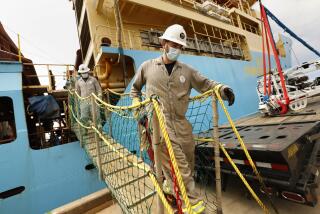Putting the Future at Risk in Oceans of Nuclear Waste
- Share via
SANTA CRUZ — One of the most pressing problems of the nuclear age is what to do with our growing inventory of radioactive wastes.
In the early years of the nuclear era, the United States and other nuclear nations simply dumped radioactive wastes into the oceans. Later studies by the Environmental Protection Agency showed that waste containers had imploded or crumbled, releasing radioactive contents into the ocean sediments, where they were free to enter the oceanic food chain. Fears that the wastes might ascend the food chain and find their way into commercial seafood prompted local, national and international moratoriums on radioactive waste dumping at sea.
Despite this troubled history, some now want to turn back the clock and again use the world’s oceans as a radioactive waste bin. Indeed, the U.S. Department of Energy spends about $10 million each year researching the possible emplacement of high-level radioactive wastes into the subseabed, a practice of questionable legality under international law.
What is the scientific consensus? Is it safe to dump radioactive wastes at sea? And should we resume the practice?
These questions have for several years preoccupied the London Dumping Convention--the only international treaty that regulates all oceanic dumping of radioactive wastes. In a 1982 report to the convention, several colleagues and I emphasized that the fate of radioactive wastes dumped into the sea was not understood well enough to guarantee safety. Most of the parties to the convention agreed and placed a two-year moratorium on nuclear dumping at sea pending further studies by the International Atomic Energy Agency (IAEA).
The IAEA report, prepared over a two-year period by two dozen scientists from the nuclear industry, government specialists and independent marine scientists, confirms our worst fears: Ocean dumping of even low-level radioactive wastes has already caused projected cases of “severe harm,” defined as deaths from cancer and debilitating genetic disorders.
The report quantifies the damage from past dumping at a single Atlantic site as 1,000 cases of severe harm spread over the next 10,000 years. Based on the IAEA’s quantitative risk estimates, resumed sea dumping of low-level radioactive wastes for the projected lifetime of the nuclear industry at existing limits would cause 50 million deaths and/or disabling genetic disorders globally over the next 100 centuries.
The proponents of ocean dumping are correct when they claim that the risk to any single individual from ocean dumping is small, but this argument is misleading. As the IAEA report decisively shows, when this risk is multiplied by the exposed population for the full duration of exposure, the resultant hazard is far from insignificant.
The IAEA’s report prompted the London Dumping Convention to vote by a 4-1 margin to continue indefinitely the moratorium on oceanic nuclear waste dumping. Remarkably, the U.S. opposed the moratorium (as did South Africa, Britain, France and Switzerland).
Some Department of Energy officials now recommend that we abandon our current prudent course and go back to the ocean option. The reason has less to do with science than with economics and politics. It is cheaper to dump radioactive wastes into the sea than to manage them responsibly on land. If nuclear industries had to bear the true cost of land-based radioactive waste management programs, they would sink further into deepening seas of red ink.
Yet even the economic advantages of sea dumping are short-term. In the long run, contamination of fisheries, consequent damage to the industry and associated health and medical costs would outweigh any cost advantages. Perhaps most frightening, there would be no way to reverse the damage. Unlike radioactive wastes on land, containers dumped at sea can’t be monitored and are irretrievable.
With respect to politics, the intensifying debate over land sites for nuclear wastes makes it clear that nobody wants these poisonous substances stored in their backyards. Fear and loathing of radioactive wastes cuts across generations, classes and the political spectrum. Faced with such broad domestic opposition, some politicians find it expedient to look to the international commons for a solution to national problems. Should they prevail, the resultant erosion of the international treaty that currently prohibits sea dumping threatens to backfire on us.
Some scientists have indeed supported the dumping of radioactive wastes at sea, but these same scientists work under contract to the Department of Energy on the subseabed-emplacement program. The evidence currently available indicates that we should stay the course by supporting the existing international moratorium on sea dumping, through appropriate national legislation and policies.
But if not the oceans, then where? The unpleasant reality is that we have in excess of 8,000 metric tons of spent reactor fuel in the United States, nearly all of it stored at production sites. The U.S. Office of Technology Assessment estimated in l982 that 150,000 metric tons would be produced by U.S. reactors then in operation or under construction. And we have around 300,000 cubic meters of additional high-level radioactive wastes--equivalent to a cubic city block--produced almost entirely by the nuclear weapons and naval reactor program. What shall we do with these already existing or committed radioactive wastes?
We cannot launch them into space--the expense alone renders this option impractical. And launch vehicles sometimes fail. Should such a failure occur with a cargo of radioactive wastes, the consequences could be catastrophic for the entire planet.
We are left, by elimination, with the land-based option--disposal of radioactive wastes on or below the surface. Deep geological repositories--mined cavities in underground salt or rock formations--represent the principal alternative considered in the United States. France has used this method for several years, mixing high-level wastes with glass (borosilicate) prior to emplacement, with no reports of leakage as yet. But such efforts are young and must be regarded as experimental. In any case, this option has its own drawbacks. It is politically controversial, expensive and, above all, cannot guarantee isolation of the radioactive wastes for the full duration of their toxicity--up to 500,000 years. We simply lack engineering experience on such time scales.
Some variation of the land option is probably the most responsible course. A relatively unexplored possibility is above-ground, retrievable storage in locations that can be monitored, pending the outcome of the European experiment and pending possible technological advances that might make underground emplacement more secure.
We are obliged to manage existing wastes as responsibly as we know how, but responsibility requires equally that we cease producing deadly wastes until there is a satisfactory disposal option. This will require increased reliance on other, non-nuclear energy sources. And it will require scaling down the nuclear arms race--the source of most of our high-level radioactive waste other than spent reactor fuel. Let us hope we have the common sense and political will to close Pandora’s nuclear box before the atom closes in on us.
More to Read
Sign up for Essential California
The most important California stories and recommendations in your inbox every morning.
You may occasionally receive promotional content from the Los Angeles Times.










